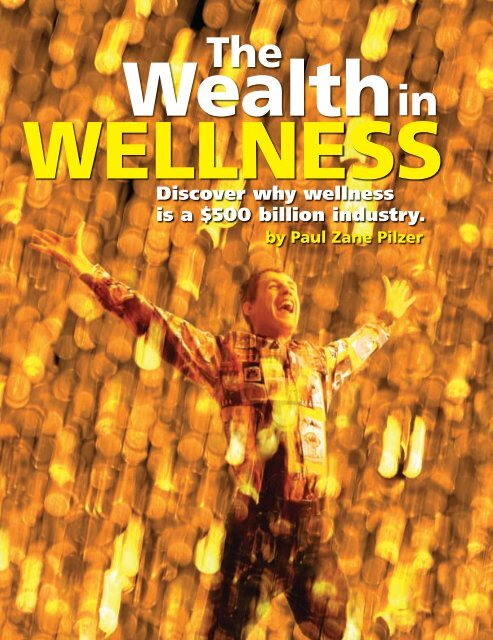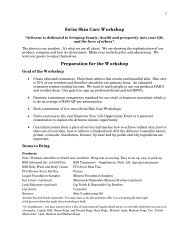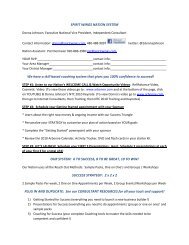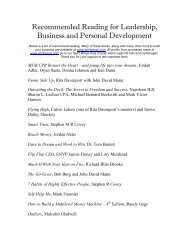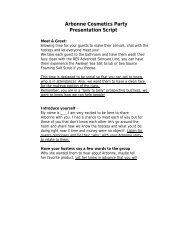download the PDF - Paul Zane Pilzer
download the PDF - Paul Zane Pilzer
download the PDF - Paul Zane Pilzer
You also want an ePaper? Increase the reach of your titles
YUMPU automatically turns print PDFs into web optimized ePapers that Google loves.
The<br />
Wealth<br />
in<br />
WELLNESS<br />
Discover why wellness<br />
is a $500 billion industry.<br />
by <strong>Paul</strong> <strong>Zane</strong> <strong>Pilzer</strong>
As baby boomers age, <strong>the</strong>y begin to desire <strong>the</strong> one thing<br />
that will allow <strong>the</strong>m to continue to enjoy <strong>the</strong> wealth <strong>the</strong>y<br />
have accumulated—wellness.<br />
What good is a vacation home in <strong>the</strong> mountains if pain prevents<br />
you from skiing, hiking or walking Or if you can’t inhale even<br />
enough oxygen to take in a cleansing breath What good is <strong>the</strong> ability<br />
to travel, if even a short walk to <strong>the</strong> beach leaves you too tired to<br />
enjoy yourself<br />
As baby boomers reach <strong>the</strong>ir 60s, wellness is becoming an investment<br />
more of our population is turning toward. Health is becoming<br />
an investment that’s affordable to almost everyone, and <strong>the</strong> dividends<br />
are priceless.<br />
The Sickness vs. Wellness Industry<br />
We’ve spent years calling doctors, hospitals, pharmacies and pharmaceutical<br />
companies <strong>the</strong> health industry, when in reality <strong>the</strong>se businesses<br />
are truly <strong>the</strong> sickness industry. The $2 trillion we spend on<br />
medical care, which represents one-sixth of <strong>the</strong> U.S. economy, is<br />
concerned almost exclusively with treating <strong>the</strong> symptoms of illness. It<br />
has very little to do with preventing illnesses or with making people<br />
feel stronger or healthier.<br />
On <strong>the</strong> o<strong>the</strong>r hand, <strong>the</strong> wellness industry includes products and<br />
services that promote wellness ra<strong>the</strong>r than respond to illness—this<br />
includes nutritional supplements, super foods and juices, personal<br />
trainers and “alternative care,” such as chiropractic.<br />
The “New” Wellness Revolution<br />
In <strong>the</strong> 1990s, I stumbled onto <strong>the</strong> wellness<br />
industry by accident. For 10 years (against medical<br />
advice), I had put off getting expensive knee<br />
surgery. Experiencing chronic pain, I began to<br />
take a supplement—glucosamine—and within a<br />
year, <strong>the</strong> cartilage was repaired. My surgeon was<br />
positively amazed when he examined my X-rays; I<br />
no longer needed surgery.<br />
I began to take a look at <strong>the</strong> true health and wellness<br />
products available—pure water, nutritional<br />
supplements, juices, pesticide- and hormone-free<br />
foods, anti-aging <strong>the</strong>rapies and alternative medical<br />
care, to name just a few. I was stunned to learn<br />
that an industry that had barely existed a decade<br />
before was already a $200 billion business—and it<br />
was just getting started.<br />
Who Is Interested in Wellness<br />
Those who are most interested in wellness are a<br />
new and growing economic sector. They are primarily<br />
wealthy people who, as <strong>the</strong>ir financial situation<br />
improves, start looking for ways <strong>the</strong>y can be<br />
healthier—and <strong>the</strong>y’re doing it outside <strong>the</strong> medical<br />
establishment. They are going to fitness clubs,<br />
PAUL ZANE PILZER IS A WORLD-<br />
RENOWNED ECONOMIST, MULTIMILLIONAIRE<br />
ENTREPRENEUR, COLLEGE PROFESSOR<br />
AND AUTHOR OF EIGHT BEST-SELLING<br />
BOOKS. WIDELY REGARDED AS A LEADING<br />
PREDICTOR OF ECONOMIC CATALYSTS<br />
AND TRENDS, PILZER HAS SERVED AS<br />
AN ECONOMIC ADVISOR TO TWO U.S.<br />
PRESIDENTS. HE HAS STARTED SEVERAL<br />
ENTREPRENEURIAL BUSINESSES—EARNING<br />
HIS FIRST MILLION BEFORE AGE 26 AND HIS<br />
FIRST $10 MILLION BEFORE AGE 30.<br />
watching what <strong>the</strong>y eat, taking <strong>the</strong> proper amounts of vitamins and<br />
minerals, and investigating supplements and o<strong>the</strong>r products that support<br />
<strong>the</strong>ir wellness. They are a growing section of our economy who<br />
are eating and living healthier than anyone ever before in history.<br />
Who are <strong>the</strong>se people Mostly baby boomers: prosperous people<br />
from <strong>the</strong> ages of 40 to 60. Baby boomers are <strong>the</strong> first generation in<br />
history that refuses to blindly accept <strong>the</strong> aging process. They are<br />
also a powerful economic force; <strong>the</strong>y represent only 28 percent of our<br />
population—yet this group represents 50 percent of our economy.<br />
Is <strong>the</strong> wellness market serving a large enough segment of <strong>the</strong><br />
population to be lucrative<br />
The Gen-Xers and Gen-Yers are definitely looking to improve <strong>the</strong>ir<br />
performance, and <strong>the</strong>y represent a significant piece of this market. But<br />
<strong>the</strong> baby boomers are a huge part of it. This generation is no longer<br />
focused on remembering what it was like to be young—<strong>the</strong>y’re buying<br />
things that actually make <strong>the</strong>m young by achieving a healthier<br />
body, more acute senses and a sharper mind!<br />
An Economic Revolution<br />
The wellness industry has only just begun.<br />
Most people don’t know such wellness products exist—much<br />
less that <strong>the</strong>y are legitimate solutions to age-old, old-age problems.<br />
But, as more learn about wellness, this sector of our economy will<br />
continue to explode.<br />
In 2000, when I began to study this trend, I was stunned to discover<br />
that wellness in America was already a $200 billion industry.<br />
Today, only a handful of years later, it has already doubled to become<br />
a $400 billion business. By 2010, just a few years<br />
from now, it will have become <strong>the</strong> next trilliondollar<br />
industry.<br />
Today’s wellness opportunities lie not only in<br />
<strong>the</strong> distribution of products, but even more so<br />
in <strong>the</strong> distribution of information—called intellectual<br />
distribution.<br />
The big-box stores, so prevalent in this decade,<br />
provide an affordable way to purchase things we<br />
already know about and want.<br />
In today’s self-checkout, cash-and-carry world,<br />
you will rarely find store employees well informed<br />
about <strong>the</strong> products or even able to recommend<br />
anything that hasn’t been heavily advertised in <strong>the</strong><br />
media. These employees simply aren’t paid to be,<br />
and <strong>the</strong>refore aren’t trained to be, product experts.<br />
While <strong>the</strong> Internet is a source of useful information,<br />
it can only give you information on products<br />
you ask about. It cannot tell you about something<br />
you don’t know to ask about.<br />
So how do consumers learn about new products<br />
Today, more than ever, consumers learn<br />
about <strong>the</strong> latest products by word-of-mouth.<br />
VOLUME 3 ISSUE 4 YOUR BUSINESS | 31
PAUL ZANE PILZER<br />
The Home-Based<br />
Business Boom<br />
In <strong>the</strong> wellness industry, it usually works<br />
this way:<br />
Sam has been feeling achy, and <strong>the</strong>refore<br />
cranky, lately. He bumps into Joe, who has<br />
pep in his stride and sparkle in his eye. When<br />
Joe shares that he’s feeling great due to a new<br />
product or service he’s tried, Sam thinks, “If<br />
it worked for him, it might work for me!”<br />
After getting more information from Joe,<br />
Sam tries <strong>the</strong> product or service. When he<br />
gets <strong>the</strong> same results, he shares <strong>the</strong> information<br />
with Sue and Pat.<br />
The Next Millionaires<br />
Being an economist, and having<br />
served as an economic advisor to two<br />
U.S. presidents, I deal with large-scale<br />
trends in <strong>the</strong> economy that are measured<br />
in billions and trillions of dollars. For<br />
most of us, grasping billions and trillions<br />
of dollars is virtually unthinkable. And<br />
let’s be honest: Are you more interested<br />
in <strong>the</strong> overall economy or how factors<br />
affect your personal economy<br />
If you’re like me, you want to know,<br />
“What can I do in this economy to<br />
succeed and take care of my family”<br />
In my book The Next Millionaires, I<br />
explain where our economy has been,<br />
where it is today and where it is going.<br />
But most importantly, I bring it all down<br />
to <strong>the</strong> level of your personal economy. In<br />
1991, <strong>the</strong>re were 3.6 million households<br />
with a net worth of $1 million or more.<br />
By 2001, <strong>the</strong> number of U.S. millionaires<br />
had doubled to 7.2 million households.<br />
What Does That Have to Do With Me<br />
After <strong>the</strong> stock market crash of 2001,<br />
many felt <strong>the</strong>y’d missed <strong>the</strong>ir chance to<br />
be a part of <strong>the</strong> millionaire boom. But in<br />
<strong>the</strong> four years following 9/11 <strong>the</strong> number<br />
of millionaire households increased<br />
to over 10 million. And over <strong>the</strong> next<br />
decade, we’ll add ano<strong>the</strong>r 10 million<br />
millionaires to that fi gure.<br />
It’s not too late for you to become one<br />
of those millionaires!<br />
The information shared is not only, well,<br />
informative, but also experiential—which<br />
makes it even more effective.<br />
This word-of-mouth advertising is<br />
<strong>the</strong> most effective means available. The<br />
expert passes on not only <strong>the</strong> “how” and<br />
“why,” but also adds personal experience<br />
and credibility.<br />
Intellectual distribution becomes a financial<br />
opportunity when you begin to benefit<br />
from <strong>the</strong> impact of educating <strong>the</strong> consumer<br />
and sharing your personal experience<br />
and credibility.<br />
I’ve studied economics for more than two<br />
decades, and <strong>the</strong> best system I’ve ever seen<br />
for intellectual distribution is <strong>the</strong> direct<br />
selling business—also known as one-toone<br />
marketing, network marketing, referral<br />
marketing or relationship marketing. This<br />
home-based business takes intellectual distribution<br />
to its pinnacle—creating wealth by<br />
helping o<strong>the</strong>rs.<br />
Direct selling provides an opportunity<br />
that’s open to absolutely everyone, regardless<br />
of background, specialized skills or<br />
capital worth.<br />
Owning <strong>the</strong> Opportunity<br />
Direct selling impresses me because it<br />
allows people to begin to captain <strong>the</strong>ir own<br />
ship; <strong>the</strong>y choose <strong>the</strong> hours <strong>the</strong>y work, and<br />
through <strong>the</strong>ir activity levels <strong>the</strong>y choose<br />
how and when to increase <strong>the</strong>ir income.<br />
And with direct selling, <strong>the</strong> headaches<br />
of traditional business ownership are virtually<br />
eliminated. This business offers<br />
low startup costs, has no employees or<br />
insurance expenses, and <strong>the</strong> overhead is<br />
practically nonexistent. The direct selling<br />
business model also uses new technologies,<br />
such as <strong>the</strong> Internet, which help make it<br />
easier than ever to own a business.<br />
So, your next steps are:<br />
Investigate a wellness product or service.<br />
Make sure it’s a product or service<br />
you can become passionate about—and<br />
commit to.<br />
Invest in education and training. Your total<br />
startup investment in most direct selling<br />
businesses will be less than a hundred<br />
dollars, low compared to <strong>the</strong> cost of most<br />
startup businesses. This will purchase a<br />
business plan and system, as well as access<br />
to tools and training, much like a franchise<br />
but without <strong>the</strong> half-million dollars<br />
in initial franchise fees.<br />
A Better Quality of Life<br />
While many entrepreneurs choose to<br />
own a direct selling business because of<br />
<strong>the</strong> low overhead and fl exible (even parttime)<br />
hours, most soon discover that<br />
it’s <strong>the</strong> quality of life that keeps <strong>the</strong>m<br />
forging ahead.<br />
Direct selling allows you to schedule<br />
your work hours around family priorities—to<br />
be able to choose your priorities<br />
and live your values; that’s why you want<br />
wealth, right<br />
Like any opportunity, owning a direct<br />
selling business isn’t effortless. But it is simple,<br />
and it can create wealth for those who<br />
choose to pursue <strong>the</strong> opportunity. YB<br />
©2007 ZCI, Inc. and VideoPlus, L.P. All rights reserved.<br />
Published under an exclusive license by Momentum Media,<br />
an imprint of VideoPlus.<br />
32 | YOUR BUSINESS VOLUME 3 ISSUE 4


